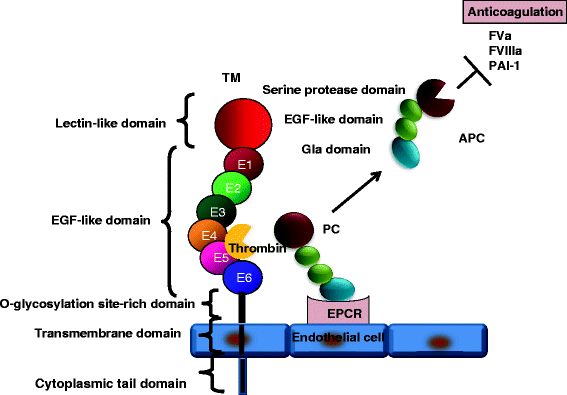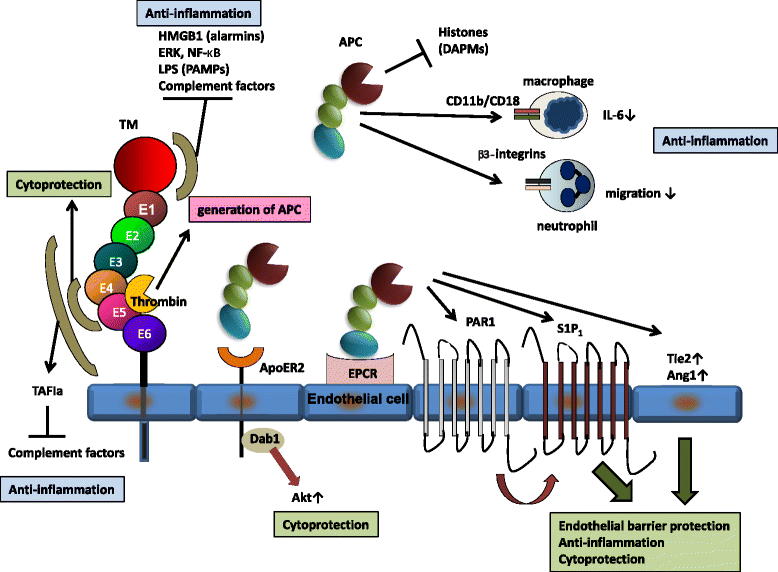Thrombomodulin/activated protein C system in septic disseminated intravascular coagulation
- PMID: 25705426
- PMCID: PMC4336127
- DOI: 10.1186/s40560-014-0050-7
Thrombomodulin/activated protein C system in septic disseminated intravascular coagulation
Abstract
The thrombomodulin (TM)/activated protein C (APC) system plays an important role in maintaining the homeostasis of thrombosis and hemostasis and maintaining vascular integrity in vivo. TM expressed on vascular endothelium binds to thrombin, forming a 1:1 complex and acts as an anticoagulant. In addition, the thrombin-TM complex activates protein C to produce APC, which inactivates factors VIIIa and Va in the presence of protein S, thereby inhibiting further thrombin formation. Intriguingly, APC possesses anti-inflammatory as well as cytoprotective activities. Moreover, the extracellular domain of TM also possesses APC-independent anti-inflammatory and cytoprotective activities. Of note, the TM/APC system is compromised in disseminated intravascular coagulation (DIC) caused by sepsis due to various mechanisms, including cleavage of cell-surface TM by exaggerated cytokines and proteases produced by activated inflammatory cells. Thus, it is reasonable to assume that reconstitution of the TM/APC system by recombinant proteins would alleviate sepsis and DIC. On the basis of the success of the Protein C Worldwide Evaluation in Severe Sepsis (PROWESS) trial, the FDA approved the use of recombinant human APC (rhAPC) for severe sepsis patients in 2002. However, subsequent clinical trials failed to show clinical benefits for rhAPC, and an increased incidence of hemorrhage-related adverse events was noted, which prompted the industry to withdraw rhAPC from the market. On the other hand, recombinant human soluble TM (rTM) has been used for treatment of individuals with DIC since 2008 in Japan, and a phase III clinical trial evaluating the efficacy of rTM in severe sepsis patients with coagulopathy is now ongoing in the USA, South America, Asia, Australia, European Union, and other countries. This review article discusses the molecular mechanisms by which the TM/APC system produces anticoagulant as well as anti-inflammatory and cytoprotective activities in septic DIC patients.
Keywords: Activated protein C; Disseminated intravascular coagulation; Sepsis; Thrombomodulin.
Figures


Similar articles
-
Thrombomodulin: A key regulator of intravascular blood coagulation, fibrinolysis, and inflammation, and a treatment for disseminated intravascular coagulation.Proc Jpn Acad Ser B Phys Biol Sci. 2025 Feb 10;101(2):75-97. doi: 10.2183/pjab.101.006. Epub 2024 Dec 18. Proc Jpn Acad Ser B Phys Biol Sci. 2025. PMID: 39694492 Free PMC article. Review.
-
Sepsis and disseminated intravascular coagulation.J Intensive Care. 2016 Mar 23;4:23. doi: 10.1186/s40560-016-0149-0. eCollection 2016. J Intensive Care. 2016. PMID: 27011792 Free PMC article. Review.
-
Thrombomodulin as an intravascular safeguard against inflammatory and thrombotic diseases.Expert Opin Ther Targets. 2016;20(2):151-8. doi: 10.1517/14728222.2016.1086750. Epub 2015 Nov 11. Expert Opin Ther Targets. 2016. PMID: 26558419 Review.
-
Circulating activated protein C levels are not increased in septic patients treated with recombinant human soluble thrombomodulin.Thromb J. 2018 Sep 28;16:24. doi: 10.1186/s12959-018-0178-0. eCollection 2018. Thromb J. 2018. PMID: 30275773 Free PMC article.
-
Thrombomodulin accelerates activated protein C production and inhibits thrombin generation in the plasma of disseminated intravascular coagulation patients.Blood Coagul Fibrinolysis. 2005 Jan;16(1):17-24. doi: 10.1097/00001721-200501000-00003. Blood Coagul Fibrinolysis. 2005. PMID: 15650541
Cited by
-
The lectin-like domain of thrombomodulin is a drug candidate for both prophylaxis and treatment of liver ischemia and reperfusion injury in mice.Am J Transplant. 2021 Feb;21(2):540-551. doi: 10.1111/ajt.16269. Epub 2020 Sep 24. Am J Transplant. 2021. PMID: 32805077 Free PMC article.
-
Present and future of anticoagulant therapy using antithrombin and thrombomodulin for sepsis-associated disseminated intravascular coagulation: a perspective from Japan.Int J Hematol. 2016 Mar;103(3):253-61. doi: 10.1007/s12185-015-1904-z. Epub 2015 Nov 20. Int J Hematol. 2016. PMID: 26588929 Review.
-
Human recombinant activated protein C-coated stent for the prevention of restenosis in porcine coronary arteries.J Mater Sci Mater Med. 2015 Oct;26(10):241. doi: 10.1007/s10856-015-5580-6. Epub 2015 Sep 28. J Mater Sci Mater Med. 2015. PMID: 26411437 Free PMC article.
-
Carbohydrate-binding protein CLEC14A regulates VEGFR-2- and VEGFR-3-dependent signals during angiogenesis and lymphangiogenesis.J Clin Invest. 2017 Feb 1;127(2):457-471. doi: 10.1172/JCI85145. Epub 2016 Dec 19. J Clin Invest. 2017. PMID: 27991863 Free PMC article.
-
The effect of activated protein C in the experimental disseminated intravascular coagulation model formed by lipopolysaccharide infusion.Acta Cir Bras. 2020 Dec 18;35(11):e351102. doi: 10.1590/ACB351102. eCollection 2020. Acta Cir Bras. 2020. PMID: 33331452 Free PMC article.
References
-
- Gando S, Saitoh D, Ogura H, Mayumi T, Koseki K, Ikeda T, Ishikura H, Iba T, Ueyama M, Eguchi Y, Ohtomo Y, Okamoto K, Kushimoto S, Endo S, Shimazaki S, Japanese Association for Acute Medicine Disseminated Intravascular Coagulation (JAAM DIC) Study Group Natural history of disseminated intravascular coagulation diagnosed based on the newly established diagnostic criteria for critically ill patients: results of a multicenter, prospective survey. Crit Care Med. 2008;36:145–150. doi: 10.1097/01.CCM.0000295317.97245.2D. - DOI - PubMed
-
- Ruf W, Edgington TS. Structural biology of tissue factor, the initiator of thrombogenesis in vivo. FASEB J. 1994;8:385–390. - PubMed
LinkOut - more resources
Full Text Sources
Other Literature Sources

